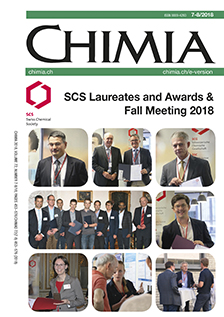Radicals and Polymers
DOI:
https://doi.org/10.2533/chimia.2018.456Keywords:
Alkoxyamine, Aminoxyl, Antioxidant, Atrp, Atra, Autoxidation, Bargellini reaction, Cool black, Controlled polymerization, Crdrp, Cr-pp, Dibenzonaphthyron, Group transfer polymerization, Hals, Hp-136, Inhibitor, Irganox®, Irgaphor®, Irgastab®, Irgatec®, Isoxindigo, Lacton, Living polymerization, Monomer, Nitroxide, Nmp, Oracet® orange lgp, Ptma, Peroxide, Organic radical battery, Process stabilizer, Radical, Redox-active polymer, Redox shuttle, StabilizationAbstract
This article describes some selected results of my 30 years as an industrial researcher. During this time, I had the chance to work on many very different projects. About two thirds of them were dealing with the fascinating interaction of radicals and polymers. Of the more than 350 million tons of industrial polymers produced worldwide every year, about 50% are made by the radical polymerization of monomers that are often stabilized against undesired premature polymerization by addition of polymerization inhibitors. Stabilizers are necessary to protect the majority of polymeric materials during their service life from radical degradation processes triggered by oxygen, heat or light. Modification of the polymeric architecture can be easily achieved via radical polymer analogous reactions. One of the most important developments in polymer science in the last 25 years is controlled radical polymerization. Recently, radical bearing redox-active polymers emerged as promising in energy storage applications, for example, in organic radical batteries. Our contributions to the fields mentioned above are described with examples of: a) novel benzofuranone stabilizers for polymers; b) the serendipidous discovery of novel dyestuffs; c) eco-friendly polymerization inhibitors; d) novel nitroxides and alkoxyamines for the first industrial realization of controlled radical polymerization; e) novel and safe radical initiators; f) nitroxide radicals bearing polymers for electrochemical applications.Downloads
Published
2018-08-22
Issue
Section
Scientific Articles
License
Copyright (c) 2018 Swiss Chemical Society

This work is licensed under a Creative Commons Attribution-NonCommercial 4.0 International License.
How to Cite
[1]
Chimia 2018, 72, 456, DOI: 10.2533/chimia.2018.456.







